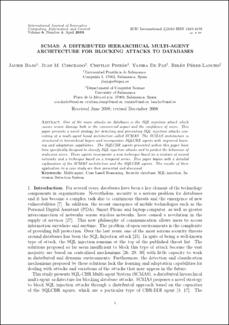Mostrar el registro sencillo del ítem
SCMAS: A distributed hierarchical multi-agent architecture for blocking attacks to databases
| dc.contributor.author | Pinzón Trejos, Cristian | |
| dc.contributor.author | Corchado, Juan | |
| dc.contributor.author | Bajo, Javier | |
| dc.contributor.author | De Paz, Yanira | |
| dc.contributor.author | Perez-Lancho, Belen | |
| dc.date.accessioned | 2018-06-05T19:29:54Z | |
| dc.date.accessioned | 2018-06-05T19:29:54Z | |
| dc.date.available | 2018-06-05T19:29:54Z | |
| dc.date.available | 2018-06-05T19:29:54Z | |
| dc.date.issued | 04/04/2010 | |
| dc.date.issued | 04/04/2010 | |
| dc.identifier.issn | 1349-4198 | |
| dc.identifier.uri | http://ridda2.utp.ac.pa/handle/123456789/4784 | |
| dc.identifier.uri | http://ridda2.utp.ac.pa/handle/123456789/4784 | |
| dc.description | One of the main attacks on databases is the SQL injection attack which causes severe damage both in the commercial aspect and the confidence of users. This paper presents a novel strategy for detecting and preventing SQL injection attacks consisting of a multi-agent based architecture called SCMAS. The SCMAS architecture is structured in hierarchical layers and incorporates SQLCBR agents with improved learning and adaptation capabilities. The SQLCBR agents presented within this paper have been specifically designed to classify SQL injection attacks and to predict the behaviour of malicious users. These agents incorporate a new technique based on a mixture of neural networks and a technique based on a temporal series. This paper begins with a detailed explanation of the SCMAS architecture and the SQLCBR agents. The results of their application to a case study are then presented and discussed. | en_US |
| dc.description.abstract | One of the main attacks on databases is the SQL injection attack which causes severe damage both in the commercial aspect and the confidence of users. This paper presents a novel strategy for detecting and preventing SQL injection attacks consisting of a multi-agent based architecture called SCMAS. The SCMAS architecture is structured in hierarchical layers and incorporates SQLCBR agents with improved learning and adaptation capabilities. The SQLCBR agents presented within this paper have been specifically designed to classify SQL injection attacks and to predict the behaviour of malicious users. These agents incorporate a new technique based on a mixture of neural networks and a technique based on a temporal series. This paper begins with a detailed explanation of the SCMAS architecture and the SQLCBR agents. The results of their application to a case study are then presented and discussed. | en_US |
| dc.format | application/pdf | |
| dc.language | eng | |
| dc.language.iso | eng | en_US |
| dc.rights | https://creativecommons.org/licenses/by-nc-sa/4.0/ | |
| dc.rights | info:eu-repo/semantics/openAccess | |
| dc.subject | Multi-agent | en_US |
| dc.subject | Case based Reasoning | en_US |
| dc.subject | Security database | en_US |
| dc.subject | SQL injection | en_US |
| dc.subject | Intrusion Detection System | en_US |
| dc.subject | Multi-agent | |
| dc.subject | Case based Reasoning | |
| dc.subject | Security database | |
| dc.subject | SQL injection | |
| dc.subject | Intrusion Detection System | |
| dc.title | SCMAS: A distributed hierarchical multi-agent architecture for blocking attacks to databases | en_US |
| dc.type | info:eu-repo/semantics/article | |
| dc.type | info:eu-repo/semantics/publishedVersion |
